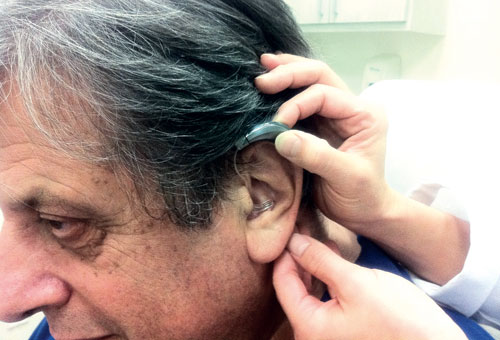https://deserthealthnews.com/story/hearing-loss-and-hearing-aids-what-you-need-to-know-part-1-of-2/
Hearing loss is a major public health issue. After arthritis and heart disease, it is the third most common chronic illness in the U.S. Unfortunately, hearing loss often goes untreated. Why is it that hearing problems often fail to prompt a visit to see a doctor?
There are many misconceptions about hearing loss and related treatment. This article, presents some of the facts and fallacies about this chronic illness that affects 35 million Americans today.
MYTH #1: “My hearing loss is normal for my age.”
FACT: Hearing loss is not normal at any age. However, many individuals will experience hearing loss as they get older. Nearly one third of adults over 65 years of age experience some degree of hearing loss.
ADVICE: If you think you have a hearing problem, see a physician to get your ears checked. You may have a build-up of ear wax, an infection, or other treatable medical condition.
MYTH #2: All hearing tests are the same – a “free” hearing test is just as good as any other.
FACT: A comprehensive hearing test performed in a sound-proof booth is the only way to obtain an accurate measure of one’s hearing loss. These are typically done by a person with an audiology degree.
ADVICE: Never consider a “free screening” test as more than a rough guestimate.
MYTH #3: My wife thinks that I have a hearing problem so I should see a hearing aid dealer to appease her.
FACT: The FDA recommends that you see a physician first. There may be a treatable medical cause for your hearing loss. Only after receiving clearance from the doctor should you consider hearing aids.
ADVICE: First see an Ear, Nose and Throat (ENT) doctor, or an Otologist (physician specializing in ear disease.) Between 5-10% of people with hearing loss are not candidates for hearing aids. Purchasing hearing aids without seeing a physician first is unsafe and is not recommended. Significant differences exist in the qualifications of individuals in healthcare and the hearing industry. There is a good reason why the FDA recommends that you first see a medical doctor (M.D.)
MYTH #4: Wearing a hearing aid is a sign of old age.
FACT: People of all ages, including infants and children, wear hearing aids. Always saying “what?”, or nodding your head in response to questions, or responding incorrectly to conversation, is a much more noticeable sign of hearing loss. Hearing aids today can be small, discrete, and even “invisible”.
MYTH #5: I don’t need to treat my hearing loss – it’s not hurting anyone.
FACT: Untreated hearing loss has negative consequences for the individual, as well as their friends and families. A study by the National Council on Aging showed that individuals with untreated hearing loss were more likely to report depression, anxiety and paranoia, and were less likely to participate in organized social activities, compared to those who wear hearing aids. In contrast, hearing aid users reported benefits in many areas of their lives, including their relationships at home, sense of independence, improved social life and even better sex lives.
ADVICE: Hearing loss should not be ignored. Hearing loss may be caused by a treatable medical condition. The FDA recommends examination by a physician (usually an otologist or ENT doctor) as the first step in evaluating hearing loss. If hearing aids are recommended, there can be significant health benefits from amplification. When hearing loss is untreated, we miss out on social conversation, which can lead to withdrawal, isolation, and depression. Social interaction is important in maintaining a state of social and psychological well-being, and may even be protective against the development of dementia.
Today’s hearing aids are sophisticated, state-of-the-art, digital devices, offering far better quality than their predecessors. They are programmed to fit an individual’s specific hearing needs. Some have blue-tooth technology, allowing one to listen to conversation, as well as the TV, and even answer the cell phone – all through their hearing aid. There are devices that require essentially no care or maintenance by the wearer. These “invisible” hearing aids are worn 24 hours a day (even when showering or sleeping,) for up to 3 months at a time, and do not require the wearer to purchase or change batteries at all.
Hearing aid technology offers significant benefits to its wearers. A successful fit can be achieved through proper evaluation. Begin with a visit to the physician, and a comprehensive hearing evaluation by an audiologist.
Dr. Kato is the founder of The Ear Institute in Palm Desert. Her top priority is improving the quality of life of her patients. Dr. Kato can be reached at: 760-565-3900.
References: National Information Center on Deafness and Other Communication Disorders, National Institutes of Health, National Council on Aging, the Marke Trak VIII Study by Sergei Kochkin, PhD, Lin. Et al. Arch Neurol. 2011;68(2):214-220. doi:10.1001/archneurol.2010.362

